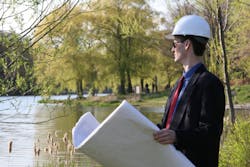Study takes collaborative approach to watershed management
AMHERST, Mass. — Sept. 15, 2015 — University of Massachusetts Amherst (UMA) scientists have prepared a new assessment that analyzes the effects of climate and land cover on watersheds in the U.S., according to a press release.
The guidance is the first continent-wide, multifactor analysis of its kind, noted the release. It assesses runoff, flooding and stormwater management options to assist professionals such as land use and town planners and water quality managers.
UMA’s watershed scientist Timothy Randhir and doctoral student Paul Ekness provided multivariate and statistical models at the watershed system level so managers can work to encourage developers to include water quality, green infrastructure and conservation plans in their projects, stated the release. Randhir and Ekness also hope cities and towns will cooperate on new developments.
The study looks at the connections between temperature and precipitation, quantifying them to the runoff process and flooding in a watershed system on a large scale, reported the release. The findings were published in the Journal of Geophysical Research: Biogeoscience’s online edition.
The analysis included data from satellite imagery, field stations, water flow observations, temperature and stream gauges from the entire U.S., shared the release.
Randhir explained in the release how ecosystems and developments affect stormwater issues. "In the past, the problems just flowed away to become some other town’s problem, but that isn’t going to work anymore."
Randhir added in the release, "There seems to be a better understanding now that water flowing away from you doesn’t just disappear, it affects someone else, and a problem in the system above you will affect you. This kind of systems thinking has to take over, and cooperation has to be used more often."
The paper makes specific recommendations about how tools such as urban forestry or increased filtration can be used to mitigate flooding, stated the release. Private landowners and farmers can also be incentivized to mitigate runoff at the source. The U.S. Department of Agriculture’s National Institute for Food and Agriculture supported the work.
